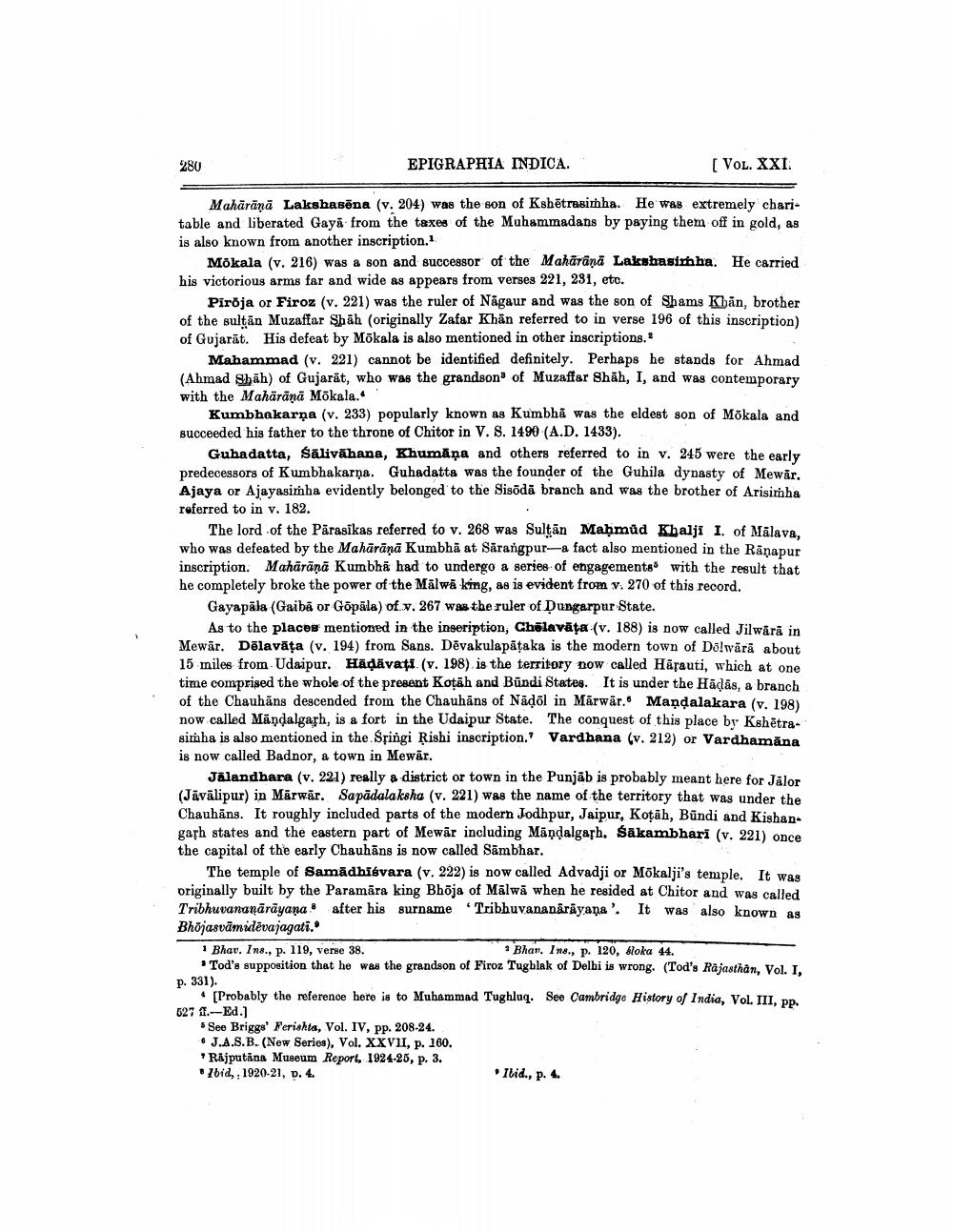________________
280
EPIGRAPHIA INDICA.
[ Vol. XXI.
Mahäränā Lakshasöna (v. 204) was the son of Kshētrasimha. He was extremely charitable and liberated Gaya from the taxes of the Muhammadans by paying them off in gold, as is also known from another inscription.
Mökala (v. 216) was a son and successor of the Mahārānā Lakshasimha. He carried his victorious arms far and wide as appears from verses 221, 231, etc.
Pirðja or Firoz (v. 221) was the ruler of Nāgaur and was the son of Shams Khan, brother of the sultan Muzaffar Shāh (originally Zafar Khan referred to in verse 196 of this inscription) of Gujarat. His defeat by Mökala is also mentioned in other inscriptions.
Mahammad (v. 221) cannot be identified definitely. Perhaps he stands for Ahmad (Ahmad Shah) of Gujarāt, who was the grandson of Muzaffar Shāh, I, and was contemporary with the Mahārāņā Mokala.
Kumbhakarņa (v. 233) popularly known as Kumbhā was the eldest son of Mökala and succeeded his father to the throne of Chitor in V. S. 1490 (A.D. 1433).
Guhadatta, Salivahana, Khumāna and others referred to in v. 245 were the early predecessors of Kumbhakarņa. Guhadatta was the founder of the Guhila dynasty of Mewăr. Ajaya or Ajayasimha evidently belonged to the Sisõdā branch and was the brother of Arisimha referred to in v. 182.
The lord of the Pärasīkas referred to v. 268 was Sultan Mahmud Khalji I. of Mälava, who was defeated by the Mahārāṇā Kumbhā at Sărangpur-a fact also mentioned in the Rāņapur inscription. Mahārānā Kumbhā had to undergo a series of engagements with the result that he completely broke the power of the Mālwā king, as is evident from v. 270 of this record.
Gayapāla (Gaibă or Gopāla) of v. 267 was the ruler of Dungarpur State.
As to the places mentioned in the inseription, Chõlavata (v. 188) is now called Jilwārā in Mewār. Dēlavāța (v. 194) from Sans. Dēvakulapāțaka is the modern town of Dolwarā about 15 miles from Udaipur. Hādāvati (v. 198) is the territory now called Härauti, which at one time comprised the whole of the present Kotāh and Būndi States. It is under the Häcās, a branch of the Chauhāns descended from the Chauhāns of Nádol in Mārwär. Mandalakara (v. 198) now called Mandalgach, is a fort in the Udaipur State. The conquest of this place by Kshētrasimha is also mentioned in the Spingi Rishi inscription.' Vardhana (v. 212) or Vardhamana is now called Badnor, a town in Mewar.
Jälandhara (v. 221) really a district or town in the Punjab is probably meant here for Jalor (Jāvālipur) in Mārwār. Sapādalaksha (v. 221) was the name of the territory that was under the Chauhāns. It roughly included parts of the modern Jodhpur, Jaipur, Kotah, Bündi and Kishan. garh states and the eastern part of Mewar including Mandalgaph. Sakambhari (v. 221) once the capital of the early Chauhāns is now called Sāmbhar.
The temple of Samādhigvara (v. 222) is now called Advadji or Mökalji's temple. It was originally built by the Paramāra king Bhöja of Mālw, when he resided at Chitor and was called Tribhuvananārāyana after his surname 'Tribhuvananārāyana'. It was also known as Bhojasvāmidēvajagati. 1 Bhav. Ing., p. 119, verse 38.
* Bhar. Ins., p. 120, kloka 44. Tod's supposition that he was the grandson of Firoz Tugblak of Delbi is wrong. (Tod's Rajasthan. Vol. I. p. 331).
(Probably the reference here is to Muhammad Tughluq. See Cambridge History of India, Vol. III, pp. 627 1.-Ed.]
See Briggs' Ferishta, Vol. IV, pp. 208-24. * J.A.S.B. (New Series), Vol. XXVII, p. 160. Rajputana Museum Report, 1924-25, p. 3. Ibid, 1920-21, p. 4.
Ibid., p. 4.




